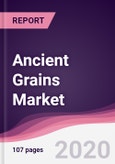The Chia ancient grains market, which forms part of the larger ancient grains market, is estimated to surpass $2,560.43m by 2023, growing at a CAGR of 36.60% during the forecast period 2018–2023. The ancient grains market is poised to witness significant growth owing to the increased applications of these grains in the food, cosmetics, pharmaceutical, and medical industries. The Americas region is the largest market for ancient grains as the market is more prevalent in South America and the U.S.
Ancient Grains Market Outlook
Ancient grains are defined as grains that remain largely unchanged over several hundred years. Ancient grains are gaining popularity among the Americans. They are being used in almost everything – from cereals, salads, breads, and crackers to pizza, quiche, and light snacks. Amaranth and quinoa have received considerable interest because of their gluten-free property. Gluten is found in other grains such as wheat, barley, and rye. Chia can be considered as a functional food because apart from contributing to human nutrition, it helps increase satiety index, and prevent cardiovascular diseases, inflammatory and nervous system disorders, and diabetes.
This report provides an in-depth analysis of the ancient grains market by grain type, application, and geography. Based on grain type, the market is majorly segmented into chia, amaranth, and quinoa.
The report also analyzes the market taking into consideration the various regions including the Americas, Europe, Asia-Pacific, and Rest of the world as well as the prominent countries for the ancient grains market across these regions. The chia ancient grains market in the Americas was valued at $199m in 2017 and is estimated to reach $1,225.37m by 2023, growing at a CAGR of 35.4% during the forecast period. The quinoa ancient grains market in the Americas was valued at $381m in 2017 and is projected to reach $2,115.76m by 2023, growing at a CAGR of 33.1% during the forecast period. The amaranth ancient grains market in the Americas was valued at $50.8m in 2017 and is estimated to reach $180,067.94m by 2023, growing at a CAGR of 23.5% during the forecast period.
Ancient Grains Market Growth Drivers
Consumer inclination towards super foods is propelling the growth of the market.
The increased aversion to grain and wheat among consumers is expected to benefit the market for pseudo-grains such as amaranth and quinoa.
Minimal effort and prerequisites for cultivating chia, amaranth and quinoa compared to other grains are set to drive the market.
The growing health-consciousness among consumers and the demand for gluten-free food & beverages have been creating an upsurge in demand for ancient grains.
Increasing demand for organic and natural products from the cosmetic industry is driving the global chia, amaranth, and quinoa markets.
Ancient Grains Market Challenges
High cost of labor, and unavailability of irrigation facilities in many regions are acting as and challenges for the market.
Growing consumption and production limitations are together causing a surge in prices for pseudo-grains such as quinoa and amaranth.
Increase in non-authentic, non-organic, non-fair trade quinoa varieties
Soil degradation caused by production intensification will result in lower yields and lower quality of chia, quinoa, and amaranth.
Ancient Grains Market
Ancient Grains Market Research Scope
The base year of the study is 2017, with forecast done up to 2023. The study presents a thorough analysis of the competitive landscape, taking into account the market shares of the leading companies. It also provides information on unit shipments. These provide the key market participants with the necessary business intelligence and help them understand the future of the grains in ancient grains market. The assessment includes the forecast, an overview of the competitive structure, the market shares of the competitors, as well as the market trends, market demands, market drivers, market challenges, and product analysis. The market drivers and restraints have been assessed to fathom their impact over the forecast period. This report further identifies the key opportunities for growth while also detailing the key challenges and possible threats. The key areas of focus include the types of ancient grains, and their specific applications.
Ancient Grains Market Report: Industry Coverage
Types of Ancient Grains: Chia, Amaranth, and Quinoa
Applications of Ancient Grains: Bakery & confectionary, infant formula, cereals, beverages, animal feed, frozen food and others
The Ancient Grains market report also analyzes the major geographic regions for the market as well as the major countries for the market in these regions. The regions and countries covered in the study include:
- The Americas: The U.S., Canada, Mexico, Brazil, Venezuela, Argentina, and Rest of Americas
- Europe: The U.K., Germany, Italy, France, Spain, Russia, Ukraine and Rest of Europe
- APAC: China, Australia, South Korea, India and Rest of APAC
- Rest of the World: The Middle East and Africa
Ancient Grains Market Key Players Perspective
Some of the key players mentioned in this report are Cargill Inc., Bunge Limited, Glanbia plc, and Archer Daniels Midland Company.
Ancient Grains Market Trends
Increasing promotion and continual innovation of ancient grains such as chia, amaranth, and quinoa in the food sector provides significant opportunities for food product manufacturers.
Growing demand for niche gluten free products
Increasing applications of chia, amaranth and quinoa in the pharmaceutical and cosmetic industries
Table of Contents
Methodology

LOADING...








